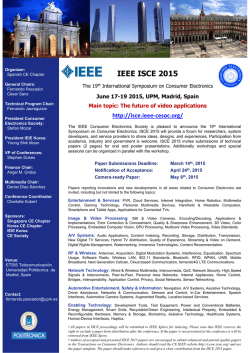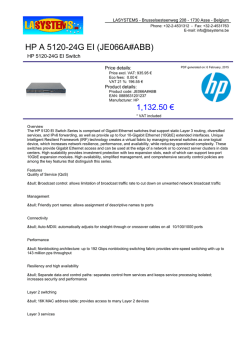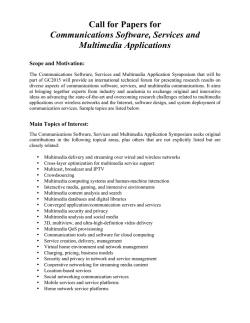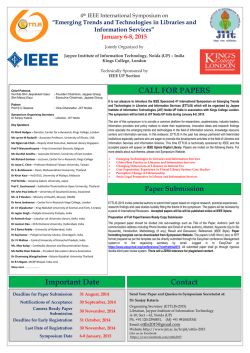
HP 1920 Switch Series - CNET Content Solutions
Data sheet HP 1920 Switch Series Key features •Customized operation using intuitive Web interface •Layer 3 static routing with 32 routes for network segmentation and expansion •Access control lists for granular security control •Spanning Tree Protocol: STP, RSTP, and MSTP •HP Limited Lifetime warranty 2.0 Product overview HP 1920 Switch Series consists of advanced smart-managed fixed-configuration Gigabit switches designed for small businesses in an easy-to-administer solution. By utilizing the latest design in silicon technology, this series is one of the most power efficient in the market. The series has 9 switches: four non-PoE models and five PoE+ models. All models are equipped with additional Gigabit SFP ports for fiber connectivity. The 8-, 24- and 48-port models are available with or without PoE+. The HP 1920 Switch Series provides a great value and includes features to satisfy even the most advanced small business network. All models support rack mounting or desktop operation. Customizable features include basic Layer 2 features like VLANs and link aggregation, as well as advanced features such as Layer 3 static routing, IPv6, ACLs, and Spanning Tree Protocols. The switches come with a limited lifetime warranty covering the unit, fans, power supplies, as well as 24x7 phone support for the first three years of ownership. Data sheet | HP 1920 Switch Series Features and benefits Management •Simple Web management Allows for easy management of the switch—even by nontechnical users—through an intuitive Web GUI; supports HTTP and HTTP Secure (HTTPS) •Single IP management Enables management of up to 32 HP 1920 switches using a single Web interface; simplifies management of multiple devices •SNMPv1, v2c, and v3 Facilitate management of the switch, as the device can be discovered and monitored from an SNMP management station •Complete session logging Provides detailed information for problem identification and resolution •Port mirroring Enables traffic on a port to be simultaneously sent to a network analyzer for monitoring •Dual flash images Provide independent primary and secondary operating system files for backup while upgrading •Management security Restricts access to critical configuration commands; offers multiple privilege levels with password protection; ACLs provide TELNET and SNMP access; local and remote syslog capabilities allow logging of all access •Network Time Protocol (NTP) Synchronizes timekeeping among distributed time servers and clients; keeps timekeeping consistent among all clock-dependent devices within the network so that the devices can provide diverse applications based on the consistent time •Limited CLI Enables users to quickly deploy and troubleshoot devices in the network •Default DHCP client mode Allows the switch to be directly connected to a network, enabling plug-and-play operation; in absence of a DHCP server on the network, the switch will fall back to a unique static address determined by the switch’s MAC address •FTP, TFTP, and SFTP support Offer different mechanisms for configuration updates; FTP allows bidirectional transfers over a TCP/IP network; trivial FTP (TFTP) is a simpler method using User Datagram Protocol (UDP); Secure File Transfer Protocol (SFTP) runs over an SSH tunnel to provide additional security •Remote monitoring (RMON) Uses standard SNMP to monitor essential network functions; supports events, alarm, history, and statistics group plus a private alarm extension group Quality of service (QoS) •Traffic prioritization Provides time-sensitive packets (like VoIP and video) with priority over other traffic based on DSCP or IEEE 802.1p classification; packets are mapped to eight hardware queues for more effective throughput •IEEE 802.1p/Q VLAN tagging Delivers data to devices based on the priority and type of traffic; supports IEEE 802.1Q •Advanced classifier based QoS Classifies traffic using multiple match criteria based on Layer 2, 3, and 4 information; applies QoS policies such as setting priority level and rate limit to selected traffic on a perport basis 2 Data sheet | HP 1920 Switch Series •Broadcast control Allows limitation of broadcast traffic rate to cut down on unwanted network broadcast traffic •Rate limiting Sets per-port ingress enforced maximums and per-port, per-queue minimums •Class of Service (CoS) Sets the IEEE 802.1p priority tag based on IP address, IP Type of Service (ToS), Layer 3 protocol, TCP/UDP port number, source port, and DiffServ •Powerful QoS feature Supports the following congestion actions: strict priority queuing (SP), weighted round robin (WRR) queuing, and SP+WRR Connectivity •IPv6 ––IPv6 host Enables switches to be managed and deployed at the IPv6 network’s edge ––IPv6 routing Supports IPv6 static routes ––MLD snooping Forwards IPv6 multicast traffic to the appropriate interface, preventing traffic flooding ––IPv6 ACL/QoS Supports ACL and QoS for IPv6 network traffic •IEEE 802.3X Flow Control Provides a flow throttling mechanism propagated through the network to prevent packet loss at a congested node •IEEE 802.3at Power over Ethernet (PoE+) Provides up to 30 W per port, which allows support of the latest PoE+-capable devices such as IP phones, wireless access points, and security cameras, as well as any IEEE 802.3afcompliant end device; mitigates the cost of additional electrical cabling and circuits that would otherwise be necessary in IP phone and WLAN deployments •Cable diagnostics Detects cable issues remotely using a browser-based tool •Flow Control Provides back pressure using standard IEEE 802.3x, reducing congestion in heavy traffic situations •Auto MDI/MDI-X Adjusts automatically for straight-through or crossover cables on all 10/100/1000 ports Security •Advanced access control lists (ACLs) Enables network traffic filtering and enhances network control using MAC- and IP-based ACLs; time-based ACLs allow for greater flexibility with managing network access •IEEE 802.1X and RADIUS network logins Controls port-based access for authentication and accountability •Secure Sockets Layer (SSL) Encrypts all HTTP traffic, allowing safe access to the browser-based management GUI in the switch •Port isolation The port isolation feature isolates Layer 2 traffic for data privacy and security without using VLANs. This feature can also be used to isolate the hosts in a VLAN from one another 3 Data sheet | HP 1920 Switch Series •Port security Combines and extends IEEE 802.1X and MAC authentication to provide MAC-based network access control •ARP attack protection The ARP detection feature enables access devices to block ARP packets from unauthorized clients to prevent user spoofing and gateway spoofing attacks •Automatic VLAN assignment Assigns users automatically to the appropriate VLAN based on their identity, location, and time of day •STP BPDU port protection Blocks Bridge Protocol Data Units (BPDUs) on ports that do not require BPDUs, preventing forged BPDU attacks •STP root guard Protects the root bridge from malicious attacks or configuration mistakes •Automatic denial-of-service protection Monitors for malicious attacks and protects the network by blocking the attacks •Management password Provides security so that only authorized access to the Web browser interface is allowed Performance •Half-and full-duplex auto-negotiating capability on every port doubles the throughput of every port •Selectable queue configurations Allows for increased performance by selecting the number of queues and associated memory buffering that best meet the requirements of the network applications •IGMP snooping Improves network performance through multicast filtering, instead of flooding traffic on all ports •Fiber uplink Provides greater distance connectivity using Gigabit Ethernet fiber uplinks Layer 2 switching •Spanning Tree Protocol (STP) Supports standard IEEE 802.1D STP, IEEE 802.1w Rapid Spanning Tree Protocol (RSTP) for faster convergence, and IEEE 802.1s Multiple Spanning Tree Protocol (MSTP) •BPDU filtering Drops BPDU packets when STP is enabled globally but disabled on a specific port •Jumbo frame support Supports up to 10 kilobyte frame size to improve the performance of large data transfers •VLAN support and tagging Support IEEE 802.1Q with 4,094 simultaneous VLAN IDs Layer 3 services •Address Resolution Protocol (ARP) Determines the MAC address of another IP host in the same subnet; supports static ARPs; gratuitous ARP allows detection of duplicate IP addresses; proxy ARP allows normal ARP operation between subnets or when subnets are separated by a Layer 2 network •DHCP Relay Simplifies management of DHCP addresses in networks with multiple subnets 4 Data sheet | HP 1920 Switch Series Layer 3 routing •Static IPv4/IPv6 routing Provides basic routing (supporting up to 32 static routes and 8 virtual VLAN interfaces); allows manual routing configuration Resiliency and high availability •Available redundant power supply Provides additional PoE of up to 795 W for high-power applications like PTZ IP cameras, video IP phones; the HP RPS1600 Redundant Power System (JG136A), which is sold separately, is for use with the HP 1920-24G-PoE+ (370W) switch and HP 1920-48G-PoE+ Switch (370W) Switch models only •Link aggregation Groups together multiple ports (up to a maximum of eight ports per trunk) automatically using Link Aggregation Control Protocol (LACP), or manually to form an ultra-high bandwidth connection to the network backbone; helps prevent traffic bottlenecks. Note: 8 port models support 4 trunks, 16 and 24 port models support 8 trunks, and 48 port models support 16 trunks Convergence •LLDP-MED (Media Endpoint Discovery) Defines a standard extension of LLDP that stores values for parameters such as QoS and VLAN to configure network devices such as IP phones automatically •PoE allocations Support multiple methods (automatic, IEEE 802.3af class, LLDP-MED, or user-specified) to allocate PoE power for more efficient energy savings •Auto-voice VLAN Recognizes IP phones and automatically assigns voice traffic to dedicated VLAN for IP phones Additional information •Green initiative support Provides support for RoHS and WEEE regulations •Green IT and power Improves energy efficiency through the use of the latest advances in silicon development; shuts off unused ports and utilizes variable-speed fans, reducing energy costs •Energy Efficient Ethernet Compliant with IEEE 802.3az standard requirements to save energy during periods of low data activity Warranty and support •HP Limited Lifetime Warranty 2.0 Advance hardware replacement for as long as you own the product with next-businessday delivery (available in most countries). See hp.com/networking/warrantysummary for duration details. •Electronic and telephone support (for Limited Lifetime Warranty 2.0) Limited 24x7 telephone support is available from HP for the first three years; limited electronic and business hours telephone support is available from HP for the entire warranty period; to reach our support centers, refer to hp.com/networking/contactsupport; for details on the duration of support provided with your product purchase, refer to hp.com/networking/warrantysummary 5 Data sheet | HP 1920 Switch Series HP 1920 Switch Series Specifications HP 1920-8G Switch (JG920A) HP 1920-8G-PoE+ (65W) Switch (JG921A) HP 1920-8G-PoE+ (180W) Switch (JG922A) I/O ports and slots 8 RJ-45 auto-negotiating 10/100/1000 ports (IEEE 802.3 Type 10BASE-T, IEEE 802.3u Type 100BASE-TX, IEEE 802.3ab Type 1000BASE-T) 2 SFP 1000 Mbps ports Supports a maximum of 8 autosensing 10/100/1000 ports plus 2 1000BASE-X SFP ports, or a combination 8 RJ-45 auto-negotiating 10/100/1000 PoE+ ports (IEEE 802.3 Type 10BASE-T, IEEE 802.3u Type 100BASE-TX, IEEE 802.3ab Type 1000BASE-T, IEEE 802.3af PoE, IEEE 802.3at) 2 SFP 1000 Mbps ports Supports a maximum of 8 autosensing 10/100/1000 ports plus 2 1000BASE-X SFP ports, or a combination 8 RJ-45 auto-negotiating 10/100/1000 PoE+ ports (IEEE 802.3 Type 10BASE-T, IEEE 802.3u Type 100BASE-TX, IEEE 802.3ab Type 1000BASE-T, IEEE 802.3af PoE, IEEE 802.3at) 2 SFP 1000 Mbps ports Supports a maximum of 8 autosensing 10/100/1000 ports plus 2 1000BASE-X SFP ports, or a combination Additional ports and slots 1 RJ-45 console port to access limited CLI port 1 RJ-45 console port to access limited CLI port 1 RJ-45 console port to access limited CLI port 10.47(w) x 6.38(d) x 1.73(h) in (26.6 x 16.2 x 4.4 cm) (1U height) 1.98 lb (0.9 kg) 12.99(w) x 9.06(d) x 1.73(h) in (33 x 23 x 4.4 cm) (1U height) 6.5 lb (2.95 kg) 12.99(w) x 9.06(d) x 1.73(h) in (33 x 23 x 4.4 cm) (1U height) 7.05 lb (3.2 kg) Memory and processor MIPS @ 500 MHz, 32 MB flash, 128 MB SDRAM; packet buffer size: 4.1 Mb MIPS @ 500 MHz, 32 MB flash, 128 MB SDRAM; packet buffer size: 4.1 Mb MIPS @ 500 MHz, 32 MB flash, 128 MB SDRAM; packet buffer size: 4.1 Mb Mounting and enclosure Mounts in an EIA standard 19-inch telco rack or equipment cabinet (hardware included), Wall Mount Mounts in an EIA standard 19-inch telco rack or equipment cabinet (hardware included) Mounts in an EIA standard 19-inch telco rack or equipment cabinet (hardware included) Performance 100 Mb Latency 1000 Mb Latency Throughput Routing/Switching capacity Routing table size MAC address table size < 5 µs < 5 µs 14.8 Mpps (64-byte packets) 20 Gbps 32 entries (IPv4), 32 entries (IPv6) 8192 entries < 5 µs < 5 µs 14.8 Mpps (64-byte packets) 20 Gbps 32 entries (IPv4), 32 entries (IPv6) 8192 entries < 5 µs < 5 µs 14.8 Mpps (64-byte packets) 20 Gbps 32 entries (IPv4), 32 entries (IPv6) 8192 entries Reliability MTBF (years) 128.20 76.33 64.51 Environment Operating temperature Operating relative humidity Nonoperating/Storage temperature Nonoperating/Storage relative humidity Altitude Acoustic 32°F to 104°F (0°C to 40°C) 10% to 90%, noncondensing -40°F to 158°F (-40°C to 70°C) 10% to 95%, noncondensing up to 16,404 ft (5 km) Pressure: 0 dB No Fan 32°F to 104°F (0°C to 40°C) 10% to 90%, noncondensing -40°F to 158°F (-40°C to 70°C) 10% to 95%, noncondensing up to 16,404 ft (5 km) Pressure: 0 dB No Fan 32°F to 104°F (0°C to 40°C) 10% to 90%, noncondensing -40°F to 158°F (-40°C to 70°C) 10% to 95%, noncondensing up to 16,404 ft (5 km) Low-speed fan: 43.6 dB, High-speed fan: 51.5 dB; ISO 7779 Physical characteristics Dimensions Weight 6 Data sheet | HP 1920 Switch Series Electrical characteristics Frequency AC voltage Maximum power rating PoE power HP 1920-8G Switch (JG920A) HP 1920-8G-PoE+ (65W) Switch (JG921A) HP 1920-8G-PoE+ (180W) Switch (JG922A) 50/60 Hz 100 - 240 VAC 9W 50/60 Hz 100 - 240 VAC 94 W 65 W PoE+ 50/60 Hz 100 - 240 VAC 235 W 180 W PoE+ Maximum power rating and maximum heat dissipation are the worst-case theoretical maximum numbers provided for planning the infrastructure with fully loaded PoE (if equipped), 100% traffic, all ports plugged in, and all modules populated. PoE power is the power supplied by the internal power supply. It is dependent on the type and quantity of power supplies. Maximum power rating and maximum heat dissipation are the worst-case theoretical maximum numbers provided for planning the infrastructure with fully loaded PoE (if equipped), 100% traffic, all ports plugged in, and all modules populated. PoE power is the power supplied by the internal power supply. It is dependent on the type and quantity of power supplies. Notes Maximum power rating and maximum heat dissipation are the worst-case theoretical maximum numbers provided for planning the infrastructure with fully loaded PoE (if equipped), 100% traffic, all ports plugged in, and all modules populated. Safety UL 60950; IEC 60950-1; EN 60950-1; CAN/CSA-C22.2 No. 60950-1-03 UL 60950; IEC 60950-1; EN 60950-1; CAN/CSA-C22.2 No. 60950-1-03 UL 60950; IEC 60950-1; EN 60950-1; CAN/CSA-C22.2 No. 60950-1-03 Emissions FCC part 15 Class A; VCCI Class A; EN 55022 Class A; CISPR 22 Class A; EN 55024; EN 61000-3-2 2000, 61000-3-3; ICES-003 Class A FCC part 15 Class A; VCCI Class A; EN 55022 Class A; CISPR 22 Class A; EN 55024; EN 61000-3-2 2000, 61000-3-3; ICES-003 Class A FCC part 15 Class A; VCCI Class A; EN 55022 Class A; CISPR 22 Class A; EN 55024; EN 61000-3-2 2000, 61000-3-3; ICES-003 Class A Management IMC—Intelligent Management Center; limited command-line interface; Web browser; SNMP Manager; IEEE 802.3 Ethernet MIB IMC—Intelligent Management Center; limited command-line interface; Web browser; SNMP Manager; IEEE 802.3 Ethernet MIB IMC—Intelligent Management Center; limited command-line interface; Web browser; SNMP Manager; IEEE 802.3 Ethernet MIB Notes SFP port and copper ports work simultaneously, independent of each other, to provide a total of 10 Gigabit switching ports. SFP port and copper ports work simultaneously, independent of each other, to provide a total of 10 Gigabit switching ports. SFP port and copper ports work simultaneously, independent of each other, to provide a total of 10 Gigabit switching ports. Services Refer to the HP website at hp.com/ networking/services for details on the service-level descriptions and product numbers. For details about services and response times in your area, please contact your local HP sales office. Refer to the HP website at hp.com/ networking/services for details on the service-level descriptions and product numbers. For details about services and response times in your area, please contact your local HP sales office. Refer to the HP website at hp.com/ networking/services for details on the service-level descriptions and product numbers. For details about services and response times in your area, please contact your local HP sales office. 7 Data sheet | HP 1920 Switch Series HP 1920 Switch Series Specifications (continued) HP 1920-16G Switch (JG923A) HP 1920-24G Switch (JG924A) HP 1920-24G-PoE+ (180W) Switch (JG925A) I/O ports and slots 16 RJ-45 auto-negotiating 10/100/1000 ports (IEEE 802.3 Type 10BASE-T, IEEE 802.3u Type 100BASETX, IEEE 802.3ab Type 1000BASE-T) 4 SFP 1000 Mbps ports Supports a maximum of 16 autosensing 10/100/1000 ports plus 4 1000BASE-X SFP ports, or a combination 24 RJ-45 auto-negotiating 10/100/1000 ports (IEEE 802.3 Type 10BASE-T, IEEE 802.3u Type 100BASETX, IEEE 802.3ab Type 1000BASE-T) 4 SFP 1000 Mbps ports Supports a maximum of 24 autosensing 10/100/1000 ports plus 4 1000BASE-X SFP ports, or a combination 24 RJ-45 auto-negotiating 10/100/1000 PoE+ ports (IEEE 802.3 Type 10BASE-T, IEEE 802.3u Type 100BASE-TX, IEEE 802.3ab Type 1000BASE-T, IEEE 802.3af PoE, IEEE 802.3at) 4 SFP 1000 Mbps ports Supports a maximum of 24 autosensing 10/100/1000 ports plus 4 1000BASE-X SFP ports, or a combination Additional ports and slots 1 RJ-45 console port to access limited CLI port 1 RJ-45 console port to access limited CLI port 1 RJ-45 console port to access limited CLI port 17.32(w) x 6.81(d) x 1.73(h) in (44 x 17.3 x 4.4 cm) (1U height) 4.74 lb (2.15 kg) 17.32(w) x 6.81(d) x 1.73(h) in (44 x 17.3 x 4.4 cm) (1U height) 4.96 lb (2.25 kg) 17.32(w) x 9.37(d) x 1.73(h) in (44 x 23.8 x 4.4 cm) (1U height) 7.5 lb (3.4 kg) Memory and processor MIPS @ 500 MHz, 32 MB flash, 128 MB SDRAM; packet buffer size: 4.1 Mb MIPS @ 500 MHz, 32 MB flash, 128 MB SDRAM; packet buffer size: 4.1 Mb MIPS @ 500 MHz, 32 MB flash, 128 MB SDRAM; packet buffer size: 4.1 Mb Mounting and enclosure Mounts in an EIA standard 19-inch telco rack or equipment cabinet (hardware included) Mounts in an EIA standard 19-inch telco rack or equipment cabinet (hardware included) Mounts in an EIA standard 19-inch telco rack or equipment cabinet (hardware included) Performance 100 Mb Latency 1000 Mb Latency Throughput Routing/Switching capacity Routing table size MAC address table size < 5 µs < 5 µs 29.8 Mpps (64-byte packets) 40 Gbps 32 entries (IPv4), 32 entries (IPv6) 8192 entries < 5 µs < 5 µs 41.7 Mpps (64-byte packets) 56 Gbps 32 entries (IPv4), 32 entries (IPv6) 8192 entries < 5 µs < 5 µs 41.7 Mpps (64-byte packets) 56 Gbps 32 entries (IPv4), 32 entries (IPv6) 8192 entries Reliability MTBF (years) 125 120.48 68.96 Environment Operating temperature Operating relative humidity Nonoperating/Storage temperature Nonoperating/Storage relative humidity Altitude Acoustic 32°F to 104°F (0°C to 40°C) 10% to 90%, noncondensing -40°F to 158°F (-40°C to 70°C) 10% to 95%, noncondensing up to 16,404 ft (5 km) No Fan 32°F to 104°F (0°C to 40°C) 10% to 90%, noncondensing -40°F to 158°F (-40°C to 70°C) 10% to 95%, noncondensing up to 16,404 ft (5 km) No Fan 32°F to 104°F (0°C to 40°C) 10% to 90%, noncondensing -40°F to 158°F (-40°C to 70°C) 10% to 95%, noncondensing up to 16,404 ft (5 km) Power: 44.9 dB, Pressure: 53.3 dB; ISO 7779 Physical characteristics Dimensions Weight 8 Data sheet | HP 1920 Switch Series HP 1920-16G Switch (JG923A) HP 1920-24G Switch (JG924A) HP 1920-24G-PoE+ (180W) Switch (JG925A) 50/60 Hz 100 - 240 VAC 13 W 50/60 Hz 100 - 240 VAC 19 W 50/60 Hz 100 - 240 VAC 235 W 180 W PoE+ Notes Maximum power rating and maximum heat dissipation are the worst-case theoretical maximum numbers provided for planning the infrastructure with fully loaded PoE (if equipped), 100% traffic, all ports plugged in, and all modules populated. Maximum power rating and maximum heat dissipation are the worst-case theoretical maximum numbers provided for planning the infrastructure with fully loaded PoE (if equipped), 100% traffic, all ports plugged in, and all modules populated. Maximum power rating and maximum heat dissipation are the worst-case theoretical maximum numbers provided for planning the infrastructure with fully loaded PoE (if equipped), 100% traffic, all ports plugged in, and all modules populated. PoE power is the power supplied by the internal power supply. It is dependent on the type and quantity of power supplies. Safety UL 60950; IEC 60950-1; EN 60950-1; CAN/CSA-C22.2 No. 60950-1-03 UL 60950; IEC 60950-1; EN 60950-1; CAN/CSA-C22.2 No. 60950-1-03 UL 60950; IEC 60950-1; EN 60950-1; CAN/CSA-C22.2 No. 60950-1-03 Emissions FCC part 15 Class A; VCCI Class A; EN 55022 Class A; CISPR 22 Class A; EN 55024; EN 61000-3-2 2000, 61000-3-3; ICES-003 Class A FCC part 15 Class A; VCCI Class A; EN 55022 Class A; CISPR 22 Class A; EN 55024; EN 61000-3-2 2000, 61000-3-3; ICES-003 Class A FCC part 15 Class A; VCCI Class A; EN 55022 Class A; CISPR 22 Class A; EN 55024; EN 61000-3-2 2000, 61000-3-3; ICES-003 Class A Management IMC—Intelligent Management Center; limited command-line interface; Web browser; SNMP Manager; IEEE 802.3 Ethernet MIB IMC—Intelligent Management Center; limited command-line interface; Web browser; SNMP Manager; IEEE 802.3 Ethernet MIB IMC—Intelligent Management Center; limited command-line interface; Web browser; SNMP Manager; IEEE 802.3 Ethernet MIB Notes SFP ports and copper ports can work simultaneously, independent of each other, to provide a total of 20 Gigabit Ethernet-capable ports. SFP ports and copper ports can work simultaneously, independent of each other, to provide a total of 28 Gigabit Ethernet-capable ports. SFP ports and copper ports can work simultaneously, independent of each other, to provide a total of 28 Gigabit Ethernet-capable ports. Services Refer to the HP website at hp.com/ networking/services for details on the service-level descriptions and product numbers. For details about services and response times in your area, please contact your local HP sales office. Refer to the HP website at hp.com/ networking/services for details on the service-level descriptions and product numbers. For details about services and response times in your area, please contact your local HP sales office. Refer to the HP website at hp.com/ networking/services for details on the service-level descriptions and product numbers. For details about services and response times in your area, please contact your local HP sales office. Electrical characteristics Frequency AC voltage Maximum power rating PoE power 9 Data sheet | HP 1920 Switch Series HP 1920 Switch Series Specifications (continued) HP 1920-24G-PoE+ (370W) Switch (JG926A) HP 1920-48G Switch (JG927A) HP 1920-48G-PoE+ (370W) Switch (JG928A) I/O ports and slots 24 RJ-45 auto-negotiating 10/100/1000 PoE+ ports (IEEE 802.3 Type 10BASE-T, IEEE 802.3u Type 100BASE-TX, IEEE 802.3ab Type 1000BASE-T, IEEE 802.3af PoE, IEEE 802.3at) 4 SFP 1000 Mbps ports Supports a maximum of 24 autosensing 10/100/1000 ports plus 4 1000BASE-X SFP ports, or a combination 48 RJ-45 auto-negotiating 10/100/1000 ports (IEEE 802.3 Type 10BASE-T, IEEE 802.3u Type 100BASETX, IEEE 802.3ab Type 1000BASE-T) 4 SFP 1000 Mbps ports Supports a maximum of 48 autosensing 10/100/1000 ports plus 4 1000BASE-X SFP ports, or a combination 48 RJ-45 auto-negotiating 10/100/1000 PoE+ ports (IEEE 802.3 Type 10BASE-T, IEEE 802.3u Type 100BASE-TX, IEEE 802.3ab Type 1000BASE-T, IEEE 802.3af PoE, IEEE 802.3at) 4 SFP 1000 Mbps ports Supports a maximum of 48 autosensing 10/100/1000 ports plus 4 1000BASE-X SFP ports, or a combination Additional ports and slots 1 RJ-45 console port to access limited CLI port 1 RJ-45 console port to access limited CLI port 1 RJ-45 console port to access limited CLI port 17.32(w) x 10.24(d) x 1.73(h) in (44 x 26 x 4.4 cm) (1U height) 7.5 lb (3.4 kg) 17.32(w) x 9.37(d) x 1.73(h) in (44 x 23.8 x 4.4 cm) (1U height) 6.94 lb (3.15 kg) 17.32(w) x 17.32(d) x 1.73(h) in (44 x 44 x 4.4 cm) (1U height) 9.48 lb (4.3 kg) Memory and processor MIPS @ 500 MHz, 32 MB flash, 128 MB SDRAM; packet buffer size: 4.1 Mb MIPS @ 650 MHz, 32 MB flash, 128 MB SDRAM; packet buffer size: 12 Mb MIPS @ 650 MHz, 32 MB flash, 128 MB SDRAM; packet buffer size: 12 Mb Mounting and enclosure Mounts in an EIA standard 19-inch telco rack or equipment cabinet (hardware included) Mounts in an EIA standard 19-inch telco rack or equipment cabinet (hardware included) Mounts in an EIA standard 19-inch telco rack or equipment cabinet (hardware included) Performance 100 Mb Latency 1000 Mb Latency Throughput Routing/Switching capacity Routing table size MAC address table size < 5 µs < 5 µs up to 41.7 Mpps (64-byte packets) 56 Gbps 32 entries (IPv4), 32 entries (IPv6) 8192 entries < 5 µs < 5 µs 77.4 Mpps (64-byte packets) 104 Gbps 32 entries (IPv4), 32 entries (IPv6) 16384 entries < 5 µs < 5 µs up to 77.4 Mpps (64-byte packets) 104 Gbps 32 entries (IPv4), 32 entries (IPv6) 16384 entries Reliability MTBF (years) 65.78 76.92 44.44 32°F to 104°F (0°C to 40°C) 10% to 90%, noncondensing -40°F to 158°F (-40°C to 70°C) 10% to 95%, noncondensing up to 16,404 ft (5 km) Low-speed fan: 44.9 dB, High-speed fan: 53.3 dB; ISO 7779 32°F to 104°F (0°C to 40°C) 10% to 90%, noncondensing -40°F to 158°F (-40°C to 70°C) 10% to 95%, noncondensing 32°F to 104°F (0°C to 40°C) 10% to 90%, noncondensing -40°F to 158°F (-40°C to 70°C) 10% to 95%, noncondensing up to 16,404 ft (5 km) Low-speed fan: 47 dB, High-speed fan: 49.3 dB; ISO 7779 Physical characteristics Dimensions Weight Environment Operating temperature Operating relative humidity Nonoperating/Storage temperature Nonoperating/Storage relative humidity Altitude Acoustic 10 Pressure: 50.0 dB; ISO 7779 Data sheet | HP 1920 Switch Series HP 1920-24G-PoE+ (370W) Switch (JG926A) HP 1920-48G Switch (JG927A) HP 1920-48G-PoE+ (370W) Switch (JG928A) Electrical characteristics Frequency 50/60 Hz AC voltage Maximum power rating PoE power 100 - 240 VAC 474 W 370 W PoE+ 50/60 Hz FYI 100 - 240 VAC 32 W 50/60 Hz 100 - 240 VAC 492 W 370 W PoE+ Maximum power rating and maximum heat dissipation are the worst-case theoretical maximum numbers provided for planning the infrastructure with fully loaded PoE (if equipped), 100% traffic, all ports plugged in, and all modules populated. Maximum power rating and maximum heat dissipation are the worst-case theoretical maximum numbers provided for planning the infrastructure with fully loaded PoE (if equipped), 100% traffic, all ports plugged in, and all modules populated. PoE power is the power supplied by the internal power supply. It is dependent on the type and quantity of power supplies and may be supplemented with the use of an external power supply (EPS). When supplemented with the use of an HP RPS1600 Redundant Power System, up to 795 W of PoE+ can be supplied. Unit max. power consumption with RPS is 876W. Notes Maximum power rating and maximum heat dissipation are the worst-case theoretical maximum numbers provided for planning the infrastructure with fully loaded PoE (if equipped), 100% traffic, all ports plugged in, and all modules populated. PoE power is the power supplied by the internal power supply. It is dependent on the type and quantity of power supplies and may be supplemented with the use of an external power supply (EPS). When supplemented with the use of an HP RPS1600 Redundant Power System, up to 795 W of PoE+ can be supplied. Unit max. power consumption with RPS is 833 W. Safety UL 60950; IEC 60950-1; EN 60950-1; CAN/CSA-C22.2 No.60950-1-03 UL 60950; IEC 60950-1; EN 60950-1; CAN/CSA-C22.2 No. 60950-1-03 UL 60950; IEC 60950-1; EN 60950-1; CAN/CSA-C22.2 No. 60950-1-03 Emissions FCC part 15 Class A; VCCI Class A; EN 55022 Class A; CISPR 22 Class A; EN 55024; EN 61000-3-2 2000, 61000-3-3; ICES-003 Class A FCC part 15 Class A; VCCI Class A; EN 55022 Class A; CISPR 22 Class A; EN 55024; EN 61000-3-2 2000, 61000-3-3; ICES-003 Class A FCC part 15 Class A; VCCI Class A; EN 55022 Class A; CISPR 22 Class A; EN 55024; EN 61000-3-2 2000, 61000-3-3; ICES-003 Class A Management IMC—Intelligent Management Center; limited command-line interface; Web browser; SNMP Manager; IEEE 802.3 Ethernet MIB IMC—Intelligent Management Center; limited command-line interface; Web browser; SNMP Manager; IEEE 802.3 Ethernet MIB IMC—Intelligent Management Center; limited command-line interface; Web browser; SNMP Manager; IEEE 802.3 Ethernet MIB Notes SFP ports and copper ports can work simultaneously, independent of each other, to provide a total of 28 Gigabit switching ports. SFP ports and copper ports work simultaneously, independent of each other, to provide a total of 52 Gigabit Ethernet-capable ports. SFP ports and copper ports can work simultaneously, independent of each other, to provide a total of 52 Gigabit switching ports. Services Refer to the HP website at hp.com/ networking/services for details on the service-level descriptions and product numbers. For details about services and response times in your area, please contact your local HP sales office. Refer to the HP website at hp.com/ networking/services for details on the service-level descriptions and product numbers. For details about services and response times in your area, please contact your local HP sales office. Refer to the HP website at hp.com/ networking/services for details on the service-level descriptions and product numbers. For details about services and response times in your area, please contact your local HP sales office. Device management RFC 2819 RMON Web UI General protocols IEEE 802.1D MAC Bridges IEEE 802.1p Priority IEEE 802.1Q VLANs IEEE 802.1s (MSTP) IEEE 802.1w Rapid Reconfiguration of Spanning Tree IEEE 802.3 Type 10BASE-T IEEE 802.3ab 1000BASE-T IEEE 802.3ad Link Aggregation Control Protocol (LACP) Standards and Protocols (applies to all products in series) IEEE 802.3i 10BASE-T IEEE 802.3x Flow Control IEEE 802.3z 1000BASE-X 11 Data sheet | HP 1920 Switch Series Standards and Protocols (applies to all products in series) MIBs RFC 1213 MIB II RFC 1493 Bridge MIB RFC 2021 RMONv2 MIB RFC 2233 Interface MIB RFC 2233 Interfaces MIB RFC 2571 SNMP Framework MIB RFC 2572 SNMP-MPD MIB RFC 2573 SNMP-Notification MIB RFC 2573 SNMP-Target MIB RFC 2613 SMON MIB RFC 2618 RADIUS Client MIB RFC 2620 RADIUS Accounting MIB RFC 2665 Ethernet-Like-MIB RFC 2667 IP Tunnel MIB RFC 2668 802.3 MAU MIB RFC 2674 802.1p and IEEE 802.1Q Bridge MIB RFC 2737 Entity MIB (Version 2) RFC 3414 SNMP-User based-SM MIB RFC 3415 SNMP-View based-ACM MIB RFC 3418 MIB for SNMPv3 Network management IEEE 802.1AB Link Layer Discovery Protocol (LLDP) IEEE 802.1D (STP) RFC 1215 SNMP Generic traps QoS/CoS IEEE 802.1P (CoS) RFC 2474 DiffServ Precedence, including 8 queues/port Security IEEE 802.1X Port Based Network Access Control HP 1920 Switch Series accessories Transceivers HP X121 1G SFP LC SX Transceiver (J4858C) HP X121 1G SFP LC LX Transceiver (J4859C) HP X121 1G SFP RJ45 T Transceiver (J8177C) HP X120 1G SFP LC SX Transceiver (JD118B) HP X120 1G SFP LC LX Transceiver (JD119B) HP X120 1G SFP RJ45 T Transceiver (JD089B) Cables HP 0.5 m Multimode OM3 LC/LC Optical Cable (AJ833A) HP 1 m Multimode OM3 LC/LC Optical Cable (AJ834A) HP 2 m Multimode OM3 LC/LC Optical Cable (AJ835A) HP 5 m Multimode OM3 LC/LC Optical Cable (AJ836A) HP 15 m Multimode OM3 LC/LC Optical Cable (AJ837A) HP 30 m Multimode OM3 LC/LC Optical Cable (AJ838A) HP 50 m Multimode OM3 LC/LC Optical Cable (AJ839A) HP Premier Flex LC/LC Multi-mode OM4 2 fiber 1m Cable (QK732A) HP Premier Flex LC/LC Multi-mode OM4 2 fiber 2m Cable (QK733A) HP Premier Flex LC/LC Multi-mode OM4 2 fiber 5m Cable (QK734A) HP Premier Flex LC/LC Multi-mode OM4 2 fiber 15m Cable (QK735A) HP Premier Flex LC/LC Multi-mode OM4 2 fiber 30m Cable (QK736A) HP Premier Flex LC/LC Multi-mode OM4 2 fiber 50m Cable (QK737A) Learn more at hp.com/networking Sign up for updates hp.com/go/getupdated Share with colleagues Rate this document © Copyright 2014–2015 Hewlett-Packard Development Company, L.P. The information contained herein is subject to change without notice. The only warranties for HP products and services are set forth in the express warranty statements accompanying such products and services. Nothing herein should be construed as constituting an additional warranty. HP shall not be liable for technical or editorial errors or omissions contained herein. 4AA5-4095ENN, January 2015, Rev. 1
© Copyright 2025









